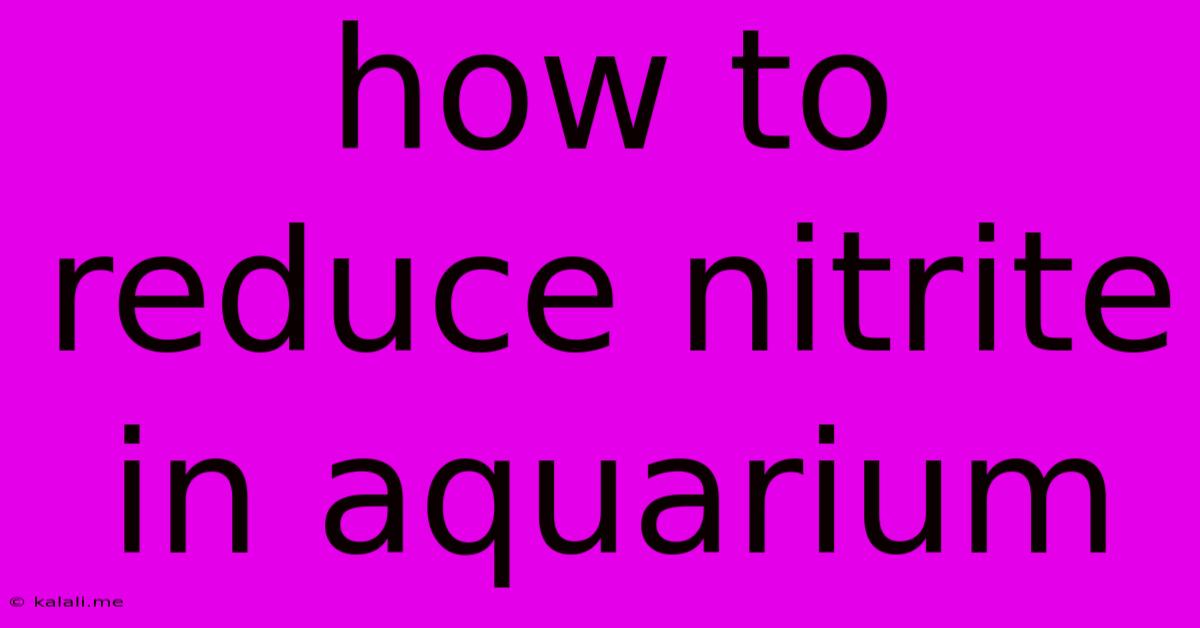How To Reduce Nitrite In Aquarium
Kalali
May 31, 2025 · 3 min read

Table of Contents
How to Reduce Nitrite in Your Aquarium: A Comprehensive Guide
Maintaining a healthy aquarium requires careful monitoring of water parameters, and nitrite (NO2) is a critical one. Elevated nitrite levels are toxic to fish and other aquatic life, so understanding how to reduce nitrite is crucial for any aquarium owner. This comprehensive guide will explore the causes of high nitrite, effective solutions, and preventative measures to keep your fish thriving.
What is Nitrite and Why is it Dangerous?
Nitrite is a byproduct of the nitrogen cycle, a natural process in which bacteria convert ammonia (a toxic waste product of fish) into less harmful nitrates. High nitrite levels occur when this cycle is disrupted, usually due to an immature or overloaded biological filter. Nitrite interferes with your fish's ability to transport oxygen through their blood, leading to suffocation even if there's plenty of dissolved oxygen in the water. Symptoms of nitrite poisoning include lethargy, rapid gill movement, and loss of appetite. High nitrite levels can be fatal if not addressed promptly.
Identifying the Root Cause of High Nitrite
Before diving into solutions, identifying the source of the problem is vital. Common causes include:
- New aquarium setup (cycling): A new tank lacks the beneficial bacteria needed to convert ammonia and nitrite. This is a normal phase, but requires patience and monitoring.
- Overstocking: Too many fish produce excessive waste, overwhelming the biological filter's capacity to process it.
- Overfeeding: Excess uneaten food decomposes, releasing ammonia and contributing to nitrite buildup.
- Filter malfunction: A clogged or improperly maintained filter reduces its effectiveness in removing waste.
- Sudden changes in water parameters: Large water changes or introducing new chemicals can disrupt the delicate balance of the nitrogen cycle.
- Dead plant matter or decaying organic material: Decomposing plants and other organic materials release ammonia into the water.
Effective Strategies to Reduce Nitrite Levels
Once you've identified the cause, you can implement these solutions:
1. Water Changes:
Performing large, frequent water changes (25-50% of the tank volume) is the quickest way to dilute nitrite levels. Use dechlorinated water matched to your tank's temperature. This is a temporary fix, though, and doesn't address the underlying cause.
2. Improve Filtration:
- Clean the filter media: Gently rinse filter media in used aquarium water, avoiding tap water which can kill beneficial bacteria. Replace old media as needed.
- Consider upgrading your filter: Choose a filter appropriate for your tank size and stocking levels. Ensure sufficient water flow to ensure proper filtration.
3. Reduce Bioload:
- Reduce stocking density: If your tank is overstocked, consider rehoming some fish.
- Adjust feeding frequency and amount: Feed less food more frequently, ensuring all food is consumed within a few minutes.
4. Addressing Dead Plant Matter and Waste:
- Remove dead plants and decaying organic matter promptly.
- Regularly vacuum the substrate: This removes decaying matter and waste buildup.
5. Patience and Time (for new tanks):
Cycling a new aquarium takes time. During this period, closely monitor nitrite levels. Using a test kit regularly is crucial. Consider using a commercially available aquarium cycling solution if the process is taking too long.
6. Avoid introducing new chemicals unnecessarily:
Unnecessary chemicals could disrupt the beneficial bacteria and further exacerbate nitrite problems.
Preventing Future Nitrite Spikes:
Preventing high nitrite levels is easier than curing them. Here's how:
- Proper aquarium cycling: Ensure your tank is properly cycled before introducing fish.
- Regular water testing: Monitor ammonia, nitrite, and nitrate levels regularly.
- Appropriate stocking levels: Avoid overcrowding your tank.
- Regular maintenance: Clean your filter, vacuum the substrate, and perform partial water changes regularly.
- Responsible feeding: Avoid overfeeding your fish.
By understanding the causes of high nitrite and implementing these strategies, you can maintain a healthy and thriving aquarium environment for your fish. Remember, consistent monitoring and proactive maintenance are key to preventing nitrite spikes and ensuring the long-term health of your aquatic pets.
Latest Posts
Latest Posts
-
Does Ice Weigh The Same As Water
Jun 02, 2025
-
Is Queso Fresco Similar To Blue Cheese
Jun 02, 2025
-
Circle With Plus Sign Symbol On Android
Jun 02, 2025
-
How To Remove A Stuck Valve Stem Cap
Jun 02, 2025
-
How To Get Rid Of Drain Flies In Bathroom
Jun 02, 2025
Related Post
Thank you for visiting our website which covers about How To Reduce Nitrite In Aquarium . We hope the information provided has been useful to you. Feel free to contact us if you have any questions or need further assistance. See you next time and don't miss to bookmark.